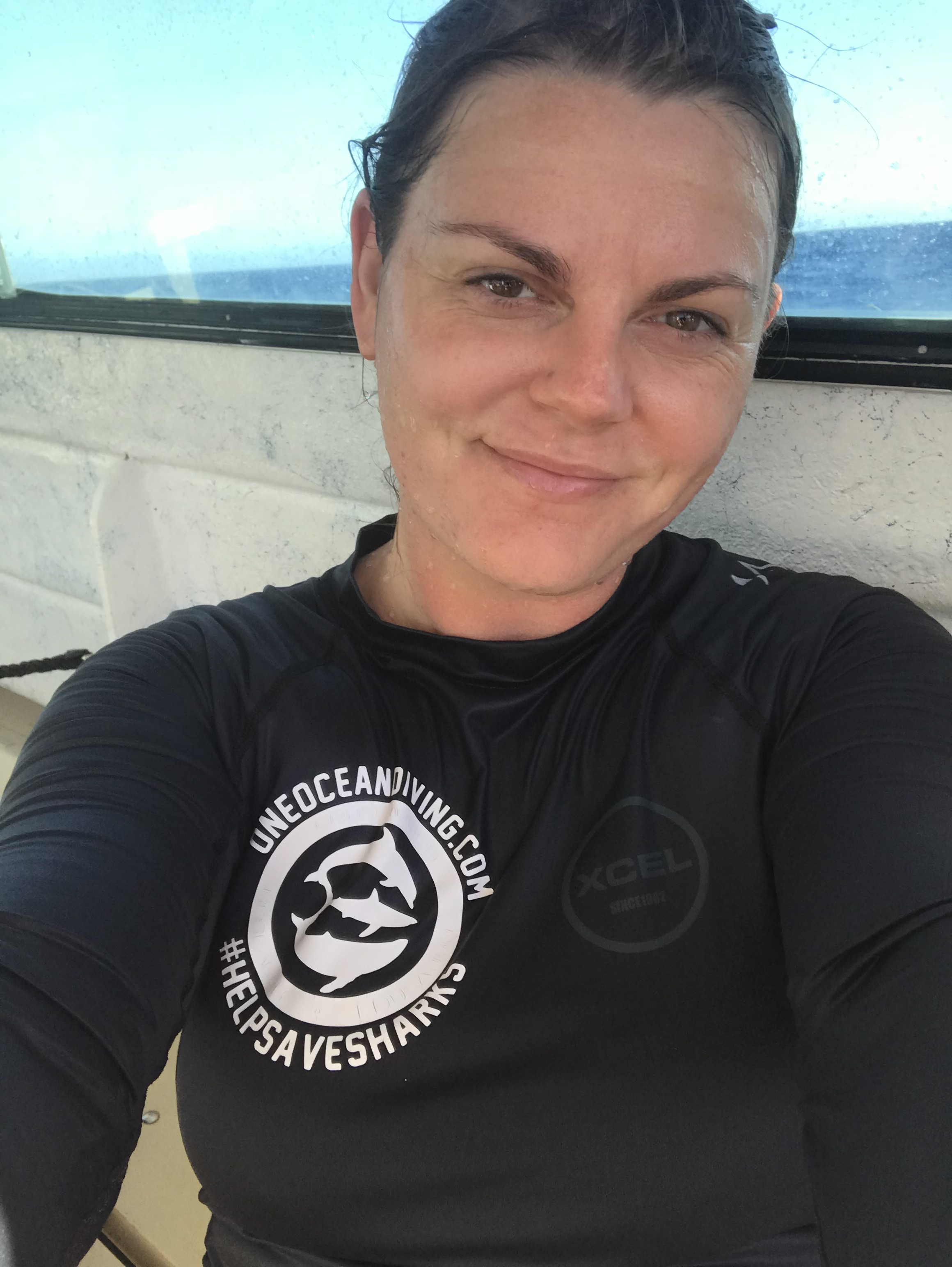View this post on Instagram
“Look over the edge and see if you can spot any silver bodies,” said a crew member from One Ocean Diving—a small shark research organization that operates out of Oahu’s North Shore.
As if summoned, the thick silhouette of a shark soared beneath the surface like an airplane gliding across the sky. It was equal parts beautiful and petrifying.
I’d never been this far out at sea, or out in the ocean on a boat this small. We were three miles off the coast of Haleiwa, Hawaii, in the pelagic zone—the open ocean.
The waves felt as tall as our vessel.
I was three years old when I first saw the movie Jaws. From then on, every swimming pool drain was a great white’s eye. Lap lines were hammer heads waiting to nibble off my toes. It took me 20 minutes to jump in the water—every time.
A little over 29 percent of Americans are afraid or very afraid of sharks, according to Chapman University’s 2018 Survey of American Fears—a number up almost 4 percent from last year. Place me in that 29 percent.
Before my dive with the company, I knew that sharks are key to the health of our oceans (read: they’re superheroes). I also knew that we’re 30 times more likely to be struck by lightning than attacked by a shark (read: not really dangerous).
Yet despite a life-long love of sharks, and a year of poring over informative Instagram posts about them, the relative gentleness of these apex predators—animals atop the food chain—failed to click. I continued to irrationally fear the razor-toothed creatures of the deep blue.
I’m not alone.
In seeming contradiction to our national fear of sharks, over 54 percent of Americans fear extinction of plant and animal species. Nearly 62 percent are afraid of ocean, river, and lake pollution, and 53.2 percent find global warming and climate change frightening.
Clearly, Americans are afraid of killing our oceans or planet, and yet we are terrified by and mass killing one of its biggest warriors—the shark.
How does the relationship of these fears fail to connect in our collective societal mind?
After my snorkel, it’s become clear to me that nothing could have erased my fear but, quite literally, plunging deep into it.
“Can they sense fear?” I asked, dipping my fins into the water.
“They can sense heart rates, so yeah,” Michelle, an apprentice with the company replied from the water. Adrenaline pulsed through my veins as I slipped myself off the boat ladder and buried my face in the sea.
I didn’t expect then that I’d come to refer to swimming with 25 sharks as one of the most relaxing experiences of my life.
But first, learning to speak shark.
The company I dived with is research-focused, and knows where and how the local sharks tend to commune. No need to chum the waters to bring them closer to the surface; just an ethical opportunity to free dive with sharks alongside a company that loves (and names) them like children.
As I tried not to fall into my neighbor’s lap during our ride across the choppy swell, I listened as Michelle spouted off information about the specific species of shark we were likely to see. We learned how to identify individuals by markings that would tell us who was who.
More importantly, we got a lesson on shark communication. Speaking this language is what would keep us safe once we plunged ourselves into what was essentially their cafeteria. It’s pretty basic: eye contact, body language, respect.
The guidelines seemed so simple. Could my gaze and a gesture that is the aquatic equivalent of “you’re in my personal bubble” actually stop a 10-foot shark from approaching any closer?
I spent my first several minutes in the water questioning the validity of these tactics:
>> I vowed not to splash so as not to mimic injured prey at the surface.
>> I swam in too-frantic circles to ensure no dominant sharks could interpret my back turned to them as an invitation to approach too closely.
>> I held my arms close to my body and kicked my flippers to avoid looking like a floating seal or turtle.
And there’s a hierarchy. Dominant sharks swim at the top of a circling, vertical tunnel of layer upon layer of sharks.
Michelle cheered from behind her snorkel as one came to investigate a floating leaf at the surface when I first got in. Later, a dominant 10-foot Galapagos shark approached me and another snorkeler twice as we held tight to our rope. The first time, eye contact was enough to divert her path.
The second, I allowed her closer before I stuck my fins out toward her nose. She swam away, and I wished then that I’d allowed her closer than the dozen or so feet that had been between us.
Midway through the 90-minute experience, I’d relaxed into my breath. Its rhythm became a meditational audio track. The sharks became somewhat of a calming lava lamp in their constant swirling, deepening, and resurfacing as Michelle and crew splashed their flippers to attract them.
The dance was predictable. It was mesmerizing.

My body came to feel cradled in the waves that I was once afraid of. I now swam in circles almost as slowly as the sharks in theirs. I took my first ever free dive down toward the topmost layer of the gliding bodies, pursuing rather than pushing away.
I wished that each member of the 29 percent of shark-fearing Americans could have this experience.
Sharks have more to fear about humans than we do of them.
In fact, we all do.
Humans kill between 100 million and 273 million sharks annually through commercial fishing vessel bycatch, trophy catches, finning for food, and even to cull, or intentionally hunt large sharks near swimming beaches to make them safer for humans.
When I think of culling, my mind returns to my free dive toward the sharks. The deeper the divers in our group pursued, the deeper our finny friends retreated in avoidance. They returned to the surface only for the investigation of the splish-splashy sound at the surface mimicking that of a meal.
The social media hashtag #apexpredatornotmonster reminds people that without sharks, significant disruptions in ocean ecology occur—an important reality to consider when presented with the fact that the world’s oceans produce more oxygen than all of Earth’s rain forests combined.
Sharks essentially serve as the maintenance crew of fish populations, and their presence or a lack of it has been found to directly influence the feeding environment and behaviors of other marine species.
They are also among the first to reflect a decline of ocean health.
Seventeen of the 39 pelagic shark species, like the ones I swam with, are threatened with extinction, according to World Wildlife Fund. An entire quarter of the world’s 494 shark and ray species face the same fate with the conservation status of an additional 35 percent of species not yet known due to insufficient data.
If we are afraid of global warming and plant and animal extinction, it is counterintuitive to fear sharks—large fish central to the health of our oceans—animals themselves on their way to extinction.
Ironically, each shark finned and tossed back into the sea removing its ability to swim and thus breathe, and every shark caught as bycatch in a commercial fishing vessel’s net, serves as a mirror of how we suffocate ourselves through our neglect to stand up to global issues of ocean sustainability and conservation.
It’s time to dive in.
I had questioned what I was doing on my way into the salty water with One Ocean Diving. Like I had before plunging into the air on a tandem skydive, in my mind I made peace with death while pushing off the boat ladder and into a world of sharp silver bodies—while menstruating, nonetheless.
Climbing back up the ladder 90 minutes later, I questioned what I was doing in a nine-to-five desk job when I could be a blissed-out warrior for the sharks I’d just made friends with. I dreamed of one day knowing the thrill of free diving peacefully alongside a Great White.
What a change from the woman who screeched at the lightest brush of seaweed across her ankle.
If we who are afraid of sharks cannot conquer our fears and dive into the world of sharks to observe and advocate for them directly (which I highly recommend), we can support legislature and organizations that protect them:
Here are a few ways to take the plunge:
>>Sign One Ocean Diving’s Hawaii Shark Bill (HB808)
>>Sign Shark Allies’ Florida Fin Trade Bill (HB99) (SB352)
>>Sign the Federal Shark Fin Sales Act of 2019 (HR373)
While headed into shore after making friends with my fears, I took what might be the most zenned-out selfie I’ve ever snapped. I know the look on my face—it’s love. And sharks need every bit of it that they can get.



 Share on bsky
Share on bsky




Read 15 comments and reply